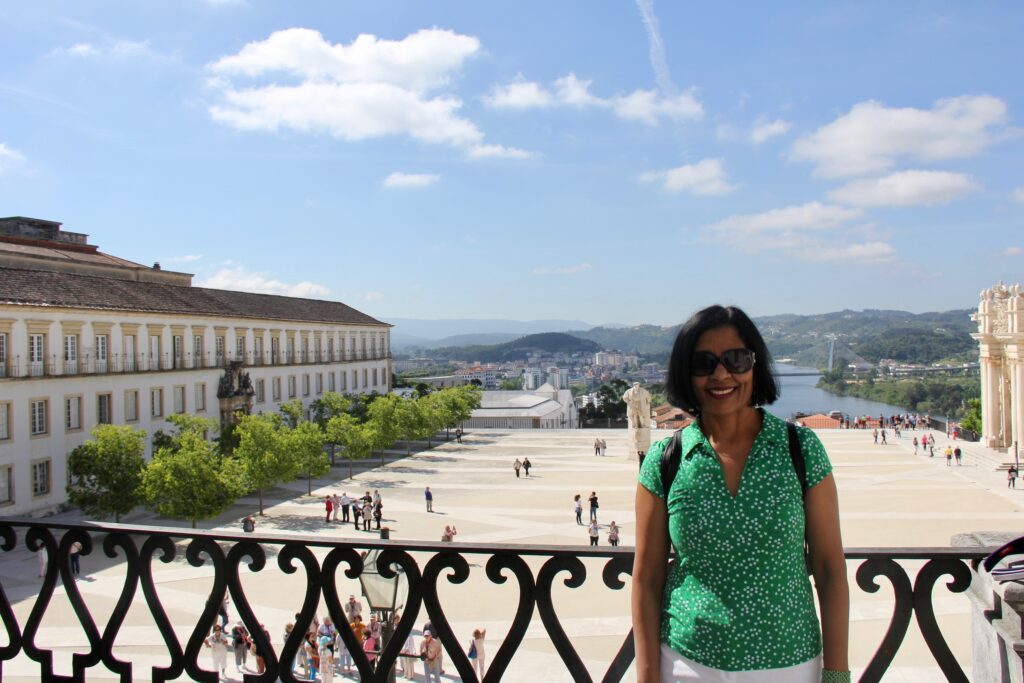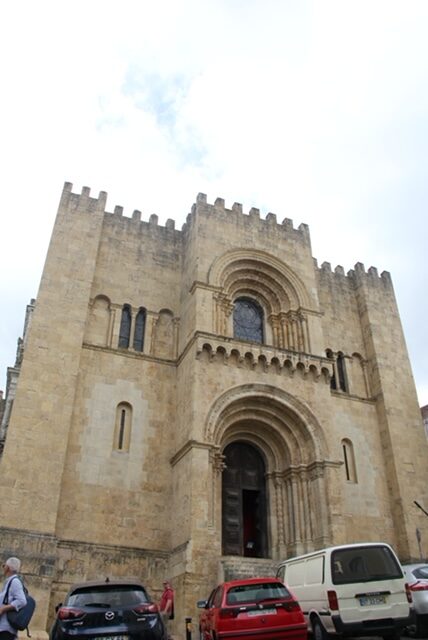Coimbra is an ancient Roman city about 122km south of Porto. It took us little more than an hour to drive to the city from Porto. The University of Coimbra is a UNESCO World Heritage Site and one of the oldest Universities in the world. We started our site seeing at the University.
University of Coimbra – To visit this oldest university in Portugal, we paid 12e in 2019. This University which is a World Heritage Site, is located on a hill in the middle of the city. It is a big tourist draw and has hundreds of years of history to show off. You can scale the 180 steps in the 16th-century tower to the highest point of the university for an awesome view of the city. Upon entering through the Porta Férrea (iron gate), you will be in the Paço das Escolas (School Hall).


Biblioteca Joanina – The university library is just stunning. When we went in 2019, every 20 minutes, about 60 people were allowed into the Library for a guided tour. This esteemed Baroque library is on the Paço das Escolas, where Portugal’s earliest kings once lived. The study tables are made of dark hardwood shipped over from Brazil. One of the curious things you’ll learn about the library is that it maintains a colony of bats bred to eat insects that would damage the books. We were not allowed to take any pictures in the library, but you can find a ton of them on internet when you do a google search.

Chapel of São Miguel (Saint Michael’s Chapel) – This University chapel dates from the 17th century. The chapel underwent subsequent renovations. The main altarpiece, was designed in 1605 and highlights the life of Christ. The altarpiece is considered a masterpiece of Portuguese mannerism. The organ in baroque style, was built in 1733 and remains functional.


View from the Tower – Paço das Escolas is dominated by this 17th century tower which holds the clock and bells that regulate academic life. It was built in 1537 when the university, which was about to be established at King John III’s palace, insisted that “there could be no order without a clock”.




Coimbra University Botanic Garden – The University’s Botanic Garden was founded in 1772 for the medical and natural history faculties. The influential botanist Avelar Brotero used the gardens in the early 19th century, and set up the university’s school for botanical studies. Lower in the valley is a bamboo plantation and forest with 51 eucalyptus species. You can enter the gardens from the Aqueduct of San Sebastian (Garden Arches) which was built between 1568-1570.



Old Cathedral of Coimbra (Se Velha) – Visiting Hours : 10am-5:30pm, Church is free 2.50e for Cloisters. This Romanesque Cathedral was built in 1139 by King Afonso Henriques not long after his victory over the Moors at the Battle of Ourique, and unlike other churches of its day has kept a lot of its Romanesque character. This church, especially the eastern facade, looks more like a fortress than a church. The intricate and gilded altar is a must see.




New Cathedral (Sé Nova) – Visiting Hours : 10am-6:30pm, Sunday 10am-12:30pm Church is free. The name “New Cathedral” is a little deceiving as this fine church is almost 500 years old. This church was founded by the Jesuits in 1598 and consecrated in 1640.



Pedro e Inês Bridge – An integral part of any walking tour in Coimbra, the Pedro e Inês Bridge is a footbridge that opened in 2007. You can see this pretty bridge from the Coimbra University Tower. You can take a walk across the bridge and you get a fantastic view of Coimbra from the bridge. The balustrade is also snazzy, made from sheets of yellow, pink, blue and green glass in an irregular geometric pattern.





Quinta das Lágrimas – The footbridge is named for the story of the 14th-century figures Pedro I the future king and Inês de Castro, his wife’s lady in waiting. They had a long affair, with Inês bearing four children, before she was assassinated in Coimbra on Pedro’s father’s orders in 1355. The park at the Quinta das Lágrimas (Estate of Tears) is supposedly where she died. The palace at the estate is now a pousada (heritage hotel), but the park is open to visitors.
Praca Do Comercio (Coimbra Plaza) – This is Coimbra’s largest square. Surrounded by 18th-century apartment buildings and businesses, it used to be the main market square and a place where people did most of their shopping. The shopping is now mostly done at the mall across the river, so the square has become a quiet place to relax at one of the cafe. In the corner of this square stands the church of São Tiago, a 12th century Romanesque church that was closed on the day we visited the place.


Other attractions in Coimbra – We did not have time to visit these.
- Monastery of Santa Cruz – Also known as the Church of the Holy Cross, it is a National Monument in Coimbra, because the first two kings of Portugal are buried in the church. Founded in 1131 outside the protecting walls of Coimbra, the Monastery of the Holy Cross was the most important monastic house during the early days of the monarchy.
- Monastery of Santa Clara-a-Velha – The monastery was built in the 14th century near Mondego River, but had to be abandoned in the 17th century due to frequent floods. The well-preserved ruins of the monastery were excavated in the late 20th century, and restored and recently reopened to the public with a new visitor center.
- Penedo da Saudade – East of the Coimbra university is a park on the hill, with a view of Coimbra, Mondego River, and the Lousã and Roxo mountains. This was where Pedro would come to grieve for Inês, and since the 19th century has been a hangout for Coimbra’s students. It is also a place for romantic encounters, and on the rocky walls of the garden are more than a century’s worth of plaques inscribed with poems (some about love, others lamenting homesickness), or commemorating distant events in the university’s past.
- Portugal dos Pequenitos – This is kind of a theme park near the Monastery of Santa Clara-a-Nova. The park has miniature models of Coimbra and Portugal’s most famous monuments and buildings. One section also has ethnographic artefacts and monuments from Portuguese-speaking African countries, Brazil, Macau, India and Timor.
- Boat ride on Mondego River
- Machado de Castro National Museum
Conímbriga – We stopped by this place on our way to Lisbon. Conímbriga is one of the largest and most intact Roman settlements excavated in Portugal and was classified as a National Monument in 1910. Excavations have also unearthed a number of exquisite floor mosaics, some astonishingly intact and covered to protect them from the elements.



